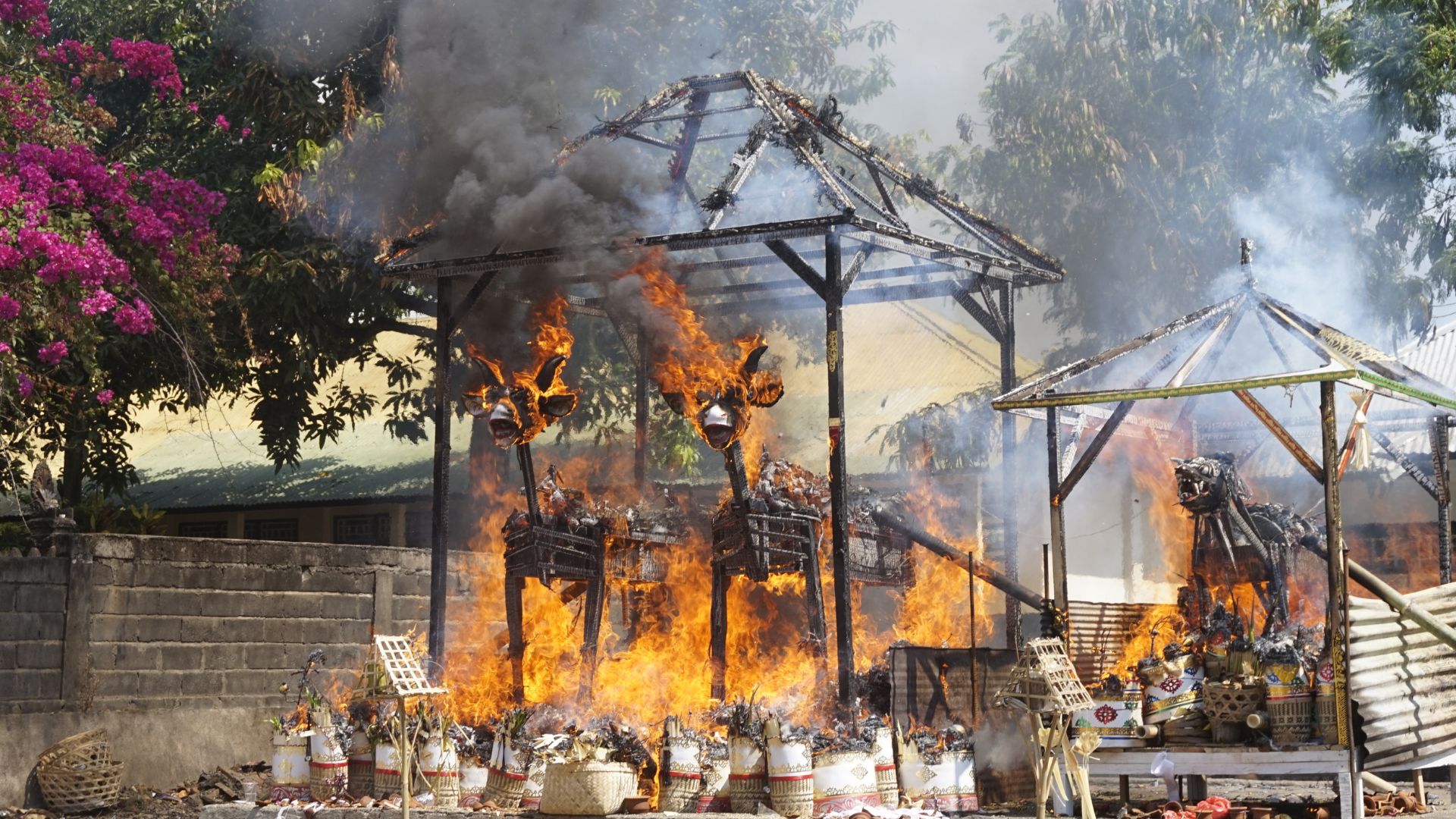Understanding the Ngaben Tradition
If you’ve ever been to Bali and witnessed a unique procession featuring a funeral parade complete with a bale, gamelan, and smoke rising high into the sky, it might have been the Ngaben ceremony. For the Balinese community, Ngaben is not just a funeral, but a sacred ritual full of meaning and spiritual belief. Let’s discuss further what Ngaben is, why bodies are cremated, and what the meaning of each part of the ceremony is.
Definition of Ngaben
Ngaben is a cremation ceremony performed by Hindus in Bali. But don’t misunderstand—the purpose of this procession is not merely to burn the body, but as a form of releasing the soul so it can return to its origin, namely the spirit realm, also known as moksha. In Balinese culture, the physical body is only considered a “temporary vehicle” during one’s life. When someone dies, all that remains is the corpse, and the soul must be freed to continue its journey to the next life or unite with the Creator. Well, that’s why Ngaben is considered very important.
The Purpose of the Ngaben Ceremony in Balinese Culture
More than just a tradition, the Ngaben ceremony has a very deep spiritual purpose. Here are some of its main objectives:
- Freeing the soul: Ngaben aims to break the soul’s attachment to the mortal world. By cremating the body, it is believed that the soul becomes lighter and can continue its journey to the next realm.
- Cleansing worldly elements: This procession is also considered a form of purification, so that the soul is not bound by emotions or unfinished worldly affairs.
- A sign of final respect: The bereaved family feels obliged to give the highest respect through the Ngaben procession. This is the last form of affection given to the deceased.
Reasons why bodies must be cremated in the Ngaben ceremony
For Hindus in Bali, cremating the body is not just a symbol, but has a deep philosophy. Fire is believed to be an element that can “return” the bodily elements to their origin—earth, water, air, and fire itself. Through cremation, all bodily elements return to nature, and the soul is freed from physical attachment. In addition, cremating the body is also believed to help the soul not get “lost” or trapped in this world.
Who can perform the Ngaben ceremony?
Generally, all Hindus in Bali can perform the Ngaben ceremony. However, its implementation can vary depending on the social status, caste, and economic ability of the bereaved family.
- Aristocratic family Ngaben: Usually performed on a large scale, with magnificent containers and complete gamelan accompaniment.
- Mass Ngaben: For families who may not have had the time or means to perform Ngaben independently, it is often done collectively with the villagers.
- Simple Ngaben: There are also those who perform it in a simple form, but still with main elements such as cremation and prayers for the soul.
So, anyone can actually perform this ceremony, as long as they fulfill the religious elements and applicable procedures.
Symbolic Meaning of the Ngaben Ceremony Stages
Ngaben is not just a procession; every detail in the ceremony has meaning. Here are some common symbols and their meanings:
- Wadah (usually in the form of a bull or tower): This is the “vehicle” that transports the soul to the next realm. Its shape sometimes resembles a sacred animal, such as a bull, and is lavishly decorated as a sign of respect.
- Baleganjur (gamelan music accompaniment): This music is not just decoration, but is believed to guide the soul so it does not get lost during its journey.
- Cremation fire: Symbolizes the purification of worldly elements and is the main element for returning the body to its origin.
- Prayers and small ceremonies before and after: All these prayers are a form of spiritual support from the family and community to ensure the soul can depart peacefully.
Ngaben Process Stages
Process or Stages in the Ngaben Ceremony
Ngaben consists of several stages, each with its own spiritual meaning. It is not done arbitrarily; everything is carried out according to customary rules and Hindu religious teachings. Here are the general stages in Ngaben:
- Ngerorasin / Ngulapin (initial purification ceremony): This is a kind of request for permission from ancestral spirits and the universe. Usually done a few days before the Ngaben day.
- Body preparation: If the body is still intact, it will usually be wrapped in white cloth and placed inside a bade (tower). If the body has been buried previously, its bones will be exhumed for the Ngaben ceremony.
- Making of Wadah / Bade: This is the tower or means that will transport the body to the cremation site. Usually its shape is tall and magnificently decorated.
- Procession to the cemetery or cremation site: The body will be paraded with baleganjur music accompaniment. Sometimes, the path is deliberately made to go in circles so that the soul is not confused and knows that it has left the world.
- Body cremation: This is the core of the ceremony. Fire is believed to free the soul from worldly attachments, allowing it to move on to the next realm.
- Nganyut and Ngasti: The ashes from the cremation are usually cast into the sea or river as a symbol of final release. After that, there is a follow-up procession to comfort the family and close the ceremony.
Differences between Mass Ngaben and Private Ngaben
Not all people perform Ngaben privately. In Bali, there is also what is known as mass Ngaben. Here are the differences:
- Private Ngaben: Performed specifically for one person. Usually carried out by families who have sufficient funds and want to give special respect. The wadah can be very large and the procession magnificent.
- Mass Ngaben: This is a Ngaben ceremony for several people at once, usually organized by the traditional village. It is suitable for families who have not had time to perform the ceremony or who want to save costs. Although it’s mass, the sacredness remains the same.
Essentially, whether mass or private, all Ngaben ceremonies have the same goal: to release the soul to the next realm with full respect.
Preparations for holding Ngaben
Before the D-day, there are many preparations that the family and community must make. Not just technical, but also spiritually. Here are some important things to prepare:
- Finding a good day (dewasa ayu): It cannot be arbitrary; a good day must be found according to the Balinese calendar.
- Coordination with pemangku or sulinggih: These are religious leaders who will lead the ceremony. Discussions must cover everything from prayers, procedures, to the ceremony schedule.
- Preparation of ceremonial facilities: This includes making bade, lembu, sesajen, and other necessary equipment.
- Family mental preparation: This is no less important. The family must be spiritually ready to let go of their loved one with sincerity.
Is the body always cremated, or are there other options?
Although the name “Ngaben” is synonymous with cremation, there are also other alternatives. Sometimes, the body is not immediately cremated, depending on the condition or family beliefs. Here are some options:
- Temporary burial: In some cases, the body is buried first for various reasons, such as waiting for a good day or waiting for a mass Ngaben. After some time, its bones are then exhumed and cremated.
- Ngelungah: This is a form of Ngaben for children or babies who died before their teeth grew. This procession is simpler and usually does not involve cremation.
- Ngaben without cremation (symbolic): If the body has been deceased for a long time or is not found, a symbolic ceremony can be performed using a doll or substitute object.
So, it’s not always necessary to cremate it right away; everything depends on the situation and family agreement, as well as local customary rules.
Meaning and Philosophy of Ngaben
Spiritual meaning behind the Ngaben ceremony
Ngaben is not a ritual performed just because “that’s the custom,” but is part of a belief deeply rooted in the lives of the Balinese people. What is the spiritual meaning of Ngaben?
- Helping the soul ‘release’ peacefully: In the Balinese Hindu view, the body is only a temporary dwelling. When someone dies, the soul must be freed from physical ties so that it can continue its journey. This is where Ngaben plays a role: as a “bridge” that transports the soul to the next realm.
- Maintaining balance between the real world and the spirit world: Balinese people believe that souls that have not been “freed” can become disturbances or get lost. With the Ngaben ceremony, souls are guided so they do not wander and can return to their origin peacefully.
- A form of final affection from the family: Ngaben also becomes a way for the family to show their last love and and devotion to the deceased. They are willing to expend energy, time, and even significant costs as a sign of final respect.
The relationship between Ngaben and the concept of reincarnation in Balinese Hinduism
One of the important concepts in Hinduism is reincarnation, which is rebirth after death. But this process does not happen automatically. There are stages that must be passed, and Ngaben is an important part of that process. How are they related?
- Ngaben = ‘Entry ticket’ to a new life: After the soul is freed through the Ngaben ceremony, it can go to another realm. It may later be reborn as a human, animal, or other creature, depending on its karma or deeds during life.
- Without Ngaben, the soul can ‘get lost’: In local belief, an uncremated soul can be confused and difficult to find its path to reincarnation. Therefore, Ngaben is performed as a guide so that the soul does not get lost or trapped in the world.
- Helping to accelerate the process towards moksha: Moksha is the highest state, where the soul no longer needs reincarnation and can unite with God. Ngaben is one of the initial steps for the soul to begin its journey towards that state.
Why is Ngaben considered important for the soul of the deceased?
For the Balinese, Ngaben is very important. Not only for the deceased, but also for the family and surrounding community. Why is that?
- So the soul is not ‘tied’ to the world: If the body is not immediately returned to nature through cremation, the soul may feel that its affairs are not yet finished. That can make the soul restless and uneasy. Ngaben helps this separation process to go well.
- As a form of social and spiritual respect: In Balinese society, Ngaben is not just a family matter. It is also a communal affair, as it is believed to impact the harmony of the universe. That’s why villagers are often directly involved, especially if Ngaben is performed en masse.
- Avoiding negative energy: Believe it or not, in local belief, an unreleased soul can carry negative energy that affects those around it. This ceremony helps neutralize that energy.
Ngaben from a Cost and Socio-Cultural Perspective
The Ngaben ceremony is one of the most sacred traditions in Bali. But behind its grandeur and spiritual meaning, many people are curious: “Actually, how much does it cost for Ngaben?” And if it’s expensive, what about families with limited income? Well, all those questions will be discussed in this section.
How much does the Ngaben ceremony cost?
The cost of the Ngaben ceremony does not have a definite figure that applies to everyone. It depends on the scale of the ceremony, the family’s social status, and the chosen form of Ngaben. But generally, the cost can range from tens of millions to hundreds of millions of rupiah. Here’s an estimated range:
- Simple Ngaben (minimalist): Starting from Rp10 million – Rp25 million. Usually performed by families with limited budgets and still prioritizing the spiritual elements.
- Standard Ngaben (ordinary family): Can cost Rp30 million – Rp100 million. This includes the cost of making the wadah, sesajen, gamelan, consumption, and the pemangku.
- Large Ngaben (aristocratic or lavish ceremony): Can exceed Rp150 million or even reach Rp500 million, especially if using a large, magnificently decorated bull and tower, accompanied by a complete gamelan.
Why can the Ngaben ceremony be so expensive?
If you have ever seen a large and magnificent Ngaben, you can immediately understand why the cost is high. But it’s not just about the appearance; here are some reasons why Ngaben costs can swell:
- Many supplies must be prepared: Starting from bade (tower), lembu (bull-shaped coffin), sesajen, to ceremonial clothing for the family and pemangku.
- Many people need to be involved: Ngaben is not a job for one or two people. There are pemangku, gamelan players, sesajen makers, dancers, construction workers to build the wadah, and many more. All of these, of course, require costs.
- Must comply with customary rules: In some traditional villages, there are standards or “guidelines” that must be met. Sometimes, this makes costs impossible to reduce as we wish.
- Long preparation time: Because this ceremony is sacred, everything must be prepared carefully and meticulously. This complex and detailed preparation contributes to the large cost.
Does every Balinese person have to perform Ngaben?
Culturally and spiritually, Balinese Hindus are obliged to perform Ngaben. Ngaben is indeed considered an obligation for Hindus in Bali as a form of final respect to the deceased. However, in practice, not everyone can immediately perform Ngaben, especially due to cost issues and family readiness. Therefore, there are several alternatives that the community undertakes:
- Ngaben postponed: The body can be temporarily buried while waiting for enough time and funds to carry out Ngaben.
- Participate in mass Ngaben: This is the most common solution for families who are not yet able to hold their own ceremony.
How can less fortunate communities perform Ngaben?
Ngaben is indeed not cheap, but that doesn’t mean that the less fortunate cannot do it. In Bali, mutual cooperation (gotong royong) and togetherness are still very strong. Here are some ways that are usually done:
- Mass Ngaben (together): Many traditional villages or banjar regularly hold collective Ngaben. The cost is much lighter because it is borne jointly, and all can still perform the ceremony according to custom.
- Assistance from the village or relatives: Sometimes, extended family, neighbors, or village officials help, either in the form of money, labor, or equipment. This has become a long-standing tradition.
- Ceremonial facilities can be adjusted: For example, not using a bade.
Conclusion
Ngaben is not just a cremation ritual, but a sacred procession that reflects the Balinese people’s belief in life after death. In Balinese Hindu belief, the soul that has left the body must be helped to continue its journey to the next realm peacefully, and that is the main role of Ngaben. This ceremony consists of important stages—from initial purification, parades, cremation, to the scattering of ashes—all laden with spiritual meaning. It is not only a form of soul release, but also a sign of final affection from the family, and for maintaining balance between the real world and the spirit realm.
Ngaben can be performed privately or en masse, depending on economic conditions and village tradition. The cost is indeed not small, especially if the ceremony is performed on a large scale. However, less fortunate communities can still hold Ngaben through mutual cooperation or by participating in mass Ngaben. Furthermore, Ngaben is also closely related to the concept of reincarnation. This procession is believed to help the soul not get trapped in the world and to reincarnate or even achieve moksha—liberation from the cycle of rebirth.
Ultimately, Ngaben is a tangible symbol of how the Balinese people view death: not as an end, but as the beginning of a new spiritual journey. Through this ceremony, they show deep love, respect, and faith in life and the universe.












